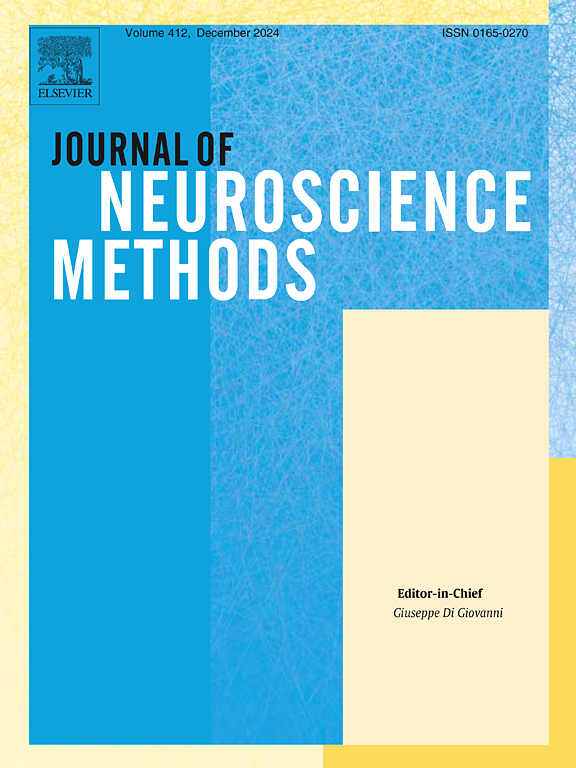Multimodal sleep signal tensor decomposition and hidden Markov Modeling for temazepam-induced anomalies across age groups
IF 2.7
4区 医学
Q2 BIOCHEMICAL RESEARCH METHODS
引用次数: 0
Abstract
Background
Recent advances in multimodal signal analysis enable the identification of subtle drug-induced anomalies in sleep that traditional methods often miss.
New method
We develop and introduce the Dynamic Representation of Multimodal Activity and Markov States (DREAMS) framework, which embeds explainable artificial intelligence (XAI) techniques to model hidden state transitions during sleep using tensorized EEG, EMG, and EOG signals from 22 subjects across three age groups (18–29, 30–49, and 50–66 years). By combining Tucker decomposition with probabilistic Hidden Markov Modeling, we quantified age-specific, temazepam-induced hidden states and significant differences in transition probabilities.
Results
Jensen-Shannon Divergence (JSD) was employed to assess variability in hidden state transitions, with older subjects (50–66 years) under temazepam displaying heightened transition variability and network instability as indicated by a 48.57 % increase in JSD (from 0.35 to 0.52) and reductions in network density by 12.5 % (from 0.48 to 0.42) and modularity by 21.88 % (from 0.32 to 0.25). These changes reflect temazepam’s disruptive impact on sleep architecture in older adults, aligning with known age-related declines in sleep stability and pharmacological sensitivity. In contrast, younger subjects exhibited lower divergence and retained relatively stable, cyclical transition patterns. Anomaly scores further quantified deviations in state transitions, with older subjects showing increased transition uncertainty and marked deviations in REM-like to NREM state transitions.
Comparison with existing methods
This XAI-driven framework provides transparent, age-specific insights into temazepam’s impact on sleep dynamics, going beyond traditional methods by identifying subtle, pharmacologically induced changes in sleep stage transitions that would otherwise be missed.
Conclusions
DREAMS supports the development of personalized interventions based on sleep transition variability across age groups, offering a powerful tool to understand temazepam’s age-dependent effects on sleep architecture.
“多模态睡眠信号张量分解和隐马尔可夫模型用于替马西泮引起的跨年龄组异常”。
背景:近年来在多模态信号分析方面取得的进展使人们能够识别出传统方法常常忽略的药物引起的睡眠异常。我们开发并引入了多模态活动和马尔可夫状态的动态表示(DREAMS)框架,该框架嵌入了可解释的人工智能(XAI)技术,使用张张化的EEG、EMG和EOG信号来模拟睡眠期间的隐藏状态转换,这些信号来自三个年龄组(18-29岁、30-49岁和50-66岁)的22名受试者。通过结合Tucker分解和概率隐马尔可夫模型,我们量化了年龄特异性、替马西泮诱导的隐藏状态和转移概率的显著差异。结果:使用Jensen-Shannon Divergence (JSD)来评估隐藏状态转换的变异性,老年受试者(50-66岁)在替马西泮下表现出更高的转换变异性和网络不稳定性,JSD增加48.57%(从0.35到0.52),网络密度减少12.5%(从0.48到0.42),模块化减少21.88%(从0.32到0.25)。这些变化反映了替马西泮对老年人睡眠结构的破坏性影响,与已知的与年龄相关的睡眠稳定性和药物敏感性下降相一致。相比之下,年轻的受试者表现出较低的分化,并保持相对稳定的周期性过渡模式。异常评分进一步量化了状态转换的偏差,年龄较大的受试者表现出更多的转换不确定性,并且在rem -样到NREM状态转换中表现出明显的偏差。与现有方法的比较:这个xai驱动的框架提供了透明的、针对特定年龄的替马西泮对睡眠动力学的影响,超越了传统方法,通过识别微妙的、药理学诱导的睡眠阶段转变,否则会被忽略。结论:DREAMS支持基于不同年龄组睡眠转换变异性的个性化干预措施的发展,为了解替马西泮对睡眠结构的年龄依赖性影响提供了有力的工具。
本文章由计算机程序翻译,如有差异,请以英文原文为准。
求助全文
约1分钟内获得全文
求助全文
来源期刊

Journal of Neuroscience Methods
医学-神经科学
CiteScore
7.10
自引率
3.30%
发文量
226
审稿时长
52 days
期刊介绍:
The Journal of Neuroscience Methods publishes papers that describe new methods that are specifically for neuroscience research conducted in invertebrates, vertebrates or in man. Major methodological improvements or important refinements of established neuroscience methods are also considered for publication. The Journal''s Scope includes all aspects of contemporary neuroscience research, including anatomical, behavioural, biochemical, cellular, computational, molecular, invasive and non-invasive imaging, optogenetic, and physiological research investigations.
 求助内容:
求助内容: 应助结果提醒方式:
应助结果提醒方式:


